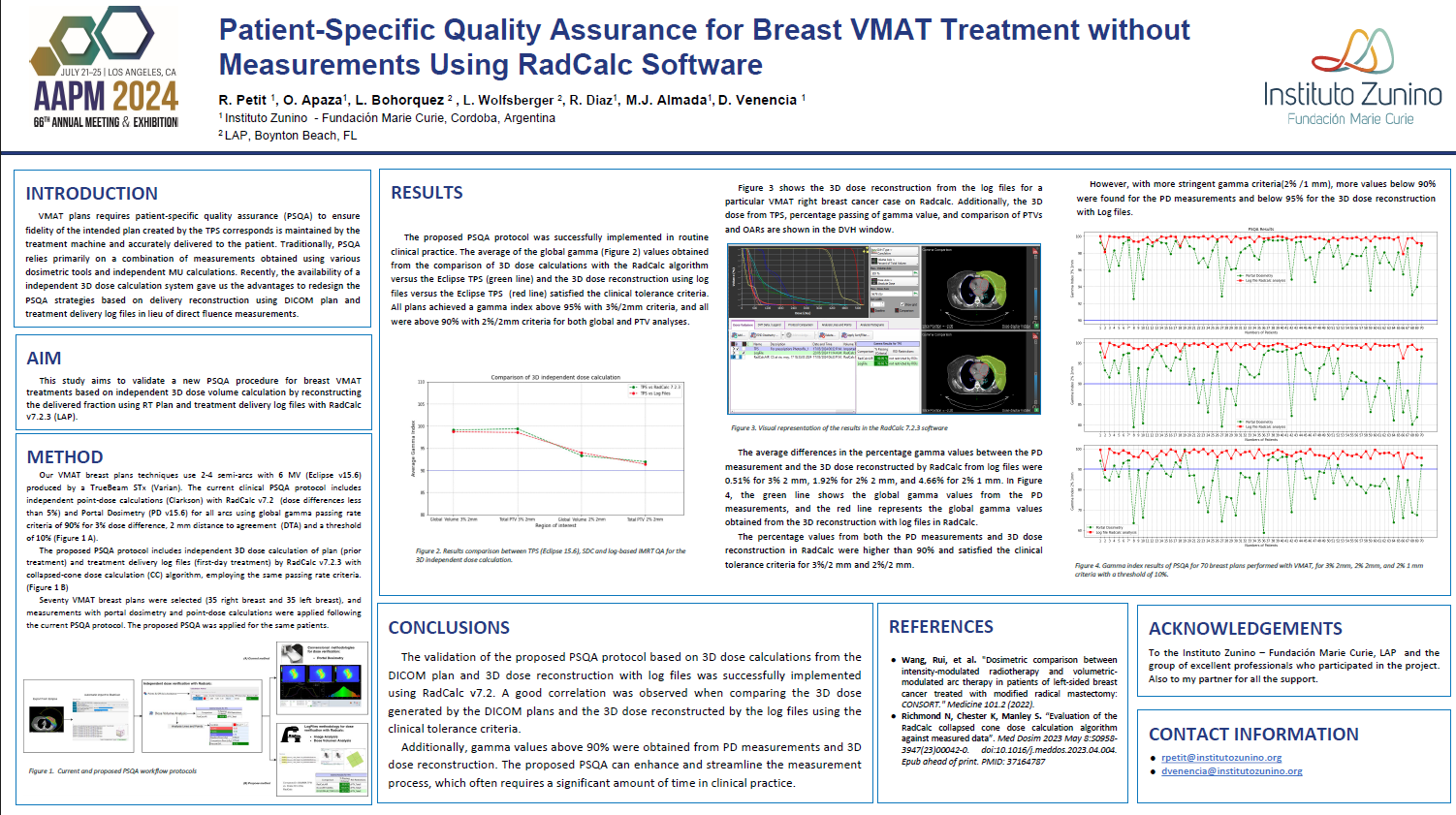Patient Specific Quality Assurance for Breast VMAT Treatment without Measurements Using RadCalc Software
Authors
R. Petit 1 , O. Apaza 1 , L. Bohorquez 2 , L. Wolfsberger 2 , R. Diaz 1 M.J. Almada 1 D. Venencia 1
1 Instituto Zunino Fundación Marie Curie, Cordoba, Argentina
2 LAP, Boynton Beach, FL
INTRODUCTION
VMAT plans requires patient-specific quality assurance (PSQA) to ensure fidelity of the intended plan created by the TPS corresponds is maintained by the treatment machine and accurately delivered to the patient Traditionally, PSQA relies primarily on a combination of measurements obtained using various dosimetric tools and independent MU calculations.
Recently, the availability of a independent 3D dose calculation system gave us the advantages to redesign the PSQA strategies based on delivery reconstruction using DICOM plan and treatment delivery log files in lieu of direct fluence measurements.
AIM
This study aims to validate a new PSQA procedure for breast VMAT treatments based on independent 3D dose volume calculation by reconstructing the delivered fraction using RT Plan and treatment delivery log files with RadCalc v7.2.3 (LAP).
METHOD
Our VMAT breast plans techniques use 2-4 semi arcs with 6 MV (Eclipse v 15.6 produced by a TrueBeam STx) The current clinical PSQA protocol includes independent point dose calculations with RadCalc v7.2 (dose differences less than 5%) and Portal Dosimetry (PD v 15.6) for all arcs using global gamma passing rate criteria of 90% for 3% dose difference, 2 mm distance to agreement (and a threshold of 10%).
The proposed PSQA protocol includes independent 3D dose calculation of plan (prior treatment) and treatment delivery log files (first day treatment) by RadCalc v7.2.3 with collapsed cone dose calculation algorithm, employing the same passing rate criteria.
Seventy VMAT breast plans were selected (35 right breast and 35 left breast), and measurements with portal dosimetry and point dose calculations were applied following the current PSQA protocol The proposed PSQA was applied for the same patients.
RESULTS
The proposed PSQA protocol was successfully implemented in routine clinical practice. The average of the global gamma (Figure 2) values obtained from the comparison of 3D dose calculations with the RadCalc algorithm versus the Eclipse TPS (green line) and the 3D dose reconstruction using log files versus the Eclipse TPS (red line) satisfied the clinical tolerance criteria. All plans achieved a gamma index above 95% with 3%/ 2 mm criteria, and all were above 90% with 2%/ 2 mm criteria for both global and PTV analyses.
Our figure shows the 3D dose reconstruction from the log files for a particular VMAT right breast cancer case on Radcalc Additionally, the 3D dose from TPS, percentage passing of gamma value, and comparison of PTVs and OARs are shown in the DVH window.
The average differences in the percentage gamma values between the PD measurement and the 3D dose reconstructed by RadCalc from log files were 0.51% for 3% 2 mm, 1.92% for 2% 2 mm, and 4.66% for 2% 1 mm. In Figure 4, the green line shows the global gamma values from the PD measurements, and the red line represents the global gamma values obtained from the 3D reconstruction with log files in RadCalc.
The percentage values from both the PD measurements and 3D dose reconstruction in RadCalc were higher than 90% and satisfied the clinical tolerance criteria for 3%/ 2 mm and 2%/ 2 mm. Visual representation of the results in the RadCalc 7.2.3 software.
However, with more stringent gamma criteria(2%/ 1 mm), more values below 90% were found for the PD measurements and below 95% for the 3D dose reconstruction with Log files.
CONCLUSIONS
The validation of the proposed PSQA protocol based on 3D dose calculations from the DICOM plan and 3D dose reconstruction with log files was successfully implemented using RadCalc v7.2. A good correlation was observed when comparing the 3D dose generated by the DICOM plans and the 3D dose reconstructed by the log files using the clinical tolerance criteria.
Additionally, gamma values above 90% were obtained from PD measurements and 3D dose reconstruction. The proposed PSQA can enhance and streamline the measurement process, which often requires a significant amount of time in clinical practice.

